Every year in mid-August, Earth plows headlong into the debris left behind by Comet 109P/Swift-Tuttle. Slamming into our atmosphere at 130,000 mph, the crumbles flash to light as the Perseid meteor shower. One of the world’s most beloved cosmic spectacles, this year’s show promises to be a real crowd pleaser.
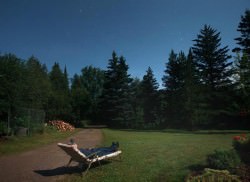
Not only will the Moon be absent, but the shower maximum happens around 3 a.m. CDT (8 UT) August 13 — early morning hours across North America when the Perseid radiant is highest. How many meteors will you see? Somewhere in the neighborhood of 50-100 meteors per hour. As always, the darker and less light polluted your observing site, the more zips and zaps you’ll see.
Find a place where there’s as few stray lights as possible, the better to allow your eyes to dark-adapt. Comfort is also key. Meteor showers are best enjoyed in a reclining position with as little neck craning as possible. Lie back on a folding lawn chair with your favorite pillow and bring a blanket to stay warm. August nights can bring chill and dew; a light coat and hat will make your that much more comfortable especially if you’re out for an hour or more.
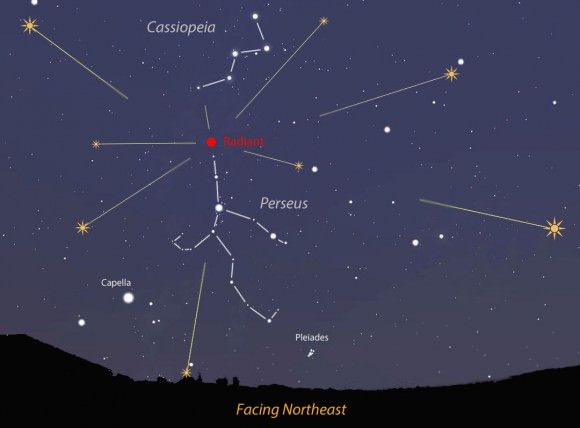
I’m always asked what’s the best direction to face. Shower meteors will show up in every corner of the sky, but can all be traced backwards to a point in Perseus called the radiant. That’s the direction from which they all appear to stream out of like bats flying out of a cave.
Another way to picture the radiant it is to imagine driving through a snowstorm at night. As you accelerate, you’ll notice that the flakes appear to radiate from a point directly in front of you, while the snow off to the sides streams away in long trails. If you’re driving at a moderate rate of speed, the snow flies past on nearly parallel paths that appear to focus in the distance the same way parallel railroad tracks converge.
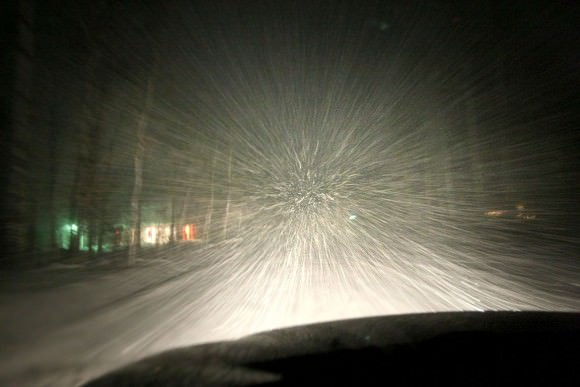
Now replace your car with the moving Earth and comet debris for snow and you’ve got a radiant and a meteor shower. With two caveats. We’re traveling at 18 1/2 miles per second and our “windshield”, the atmosphere, is more porous. Snow bounces off a car windshield, but when a bit of cosmic debris strikes the atmosphere, it vaporizes in a flash. We often think friction causes the glow of meteors, but they’re heated more by ram pressure.
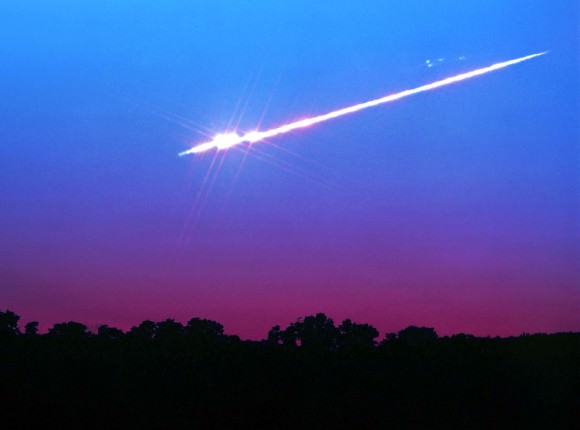
The incoming bit of ice or rock rapidly compresses and heats the air in front of it, which causes the particle to vaporize around 3,000°F (1,650°C). The meteor or bright streak we see is really a hollow “tube” of glowing or ionized air molecules created by the tiny rock as its energy of motion is transferred to the surrounding air molecules. Just as quickly, the molecules return to their rest state and release that energy as a spear of light we call a meteor.
Imagine. All it takes is something the size of a grain of sand to make us look up and yell “Wow!”
Speaking of size, most meteor shower particles range in size from a small pebble to beach sand and generally weigh less than 1-2 grams or about what a paperclip weighs. Larger chunks light up as fireballs that shine as bright as Venus or better. Because of their swiftness, Perseids are generally white and often leave chalk-like trails called trains in their wakes.
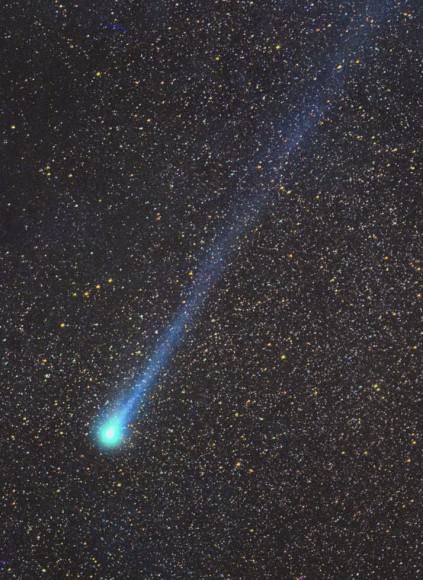
This year’s shower is special in another way. According to Sky and Telescope magazine, meteor stream modeler Jeremie Vaubaillon predicts a bump in the number of Perseids around 1:39 p.m. (18:39 UT) as Earth encounters a debris trail shed by the Comet Swift-Tuttle back in 1862. The time favors observers in Asia where the sky will be dark. It should be interesting to see if the prediction holds.
How To Watch
Already the shower’s active. Go out any night through about the 15th and you’ll see at least at least a handful of Perseids an hour. At nightfall on the peak night of August 12-13, you may see only 20-30 meteors an hour because the radiant is still low in the sky. But these early hours give us the opportunity to catch an earthgrazer — a long, very slow-moving meteor that skims the atmosphere at a shallow angle, crossing half the sky or more before finally fading out.
I’ve only seen one good earthgrazer in my earthly tenure, but I’ll never forget the sight. Ambling from low in the northeastern sky all the way past the southern meridian, it remained visible long enough to catch it in my telescope AND set up a camera and capture at least part of its trail!
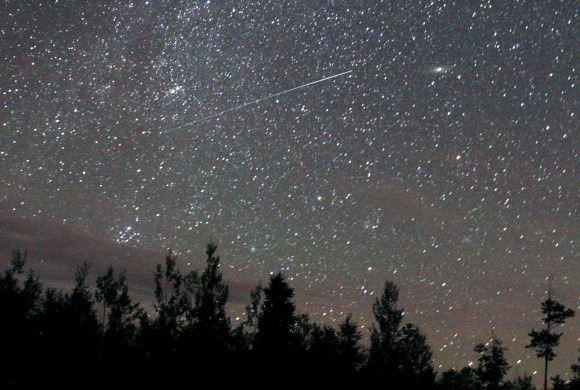
The later you stay up, the higher the radiant rises and the more meteors you’ll see. Peak activity of 50-100 meteors per hour will occur between about 2-4 a.m. No need to stare at the radiant to see meteors. You can look directly up at the darkest part of the sky or face east or southeast and look halfway up if you like. You’re going to see meteors everywhere. Some will arrive as singles, others in short burst of 2, 3, 4 or more. I like to face southeast with the radiant off to one side. That way I can see a mix of short-trailed meteors from near the radiant and longer, graceful streaks further away just like the snow photo shows.
If there’s a lull in activity, don’t think it’s over. Meteor showers have strange rhythms of their own. Five minutes of nothing can be followed by multiple hits or even a fireball. Get into the feel of the shower as you sense spaceship Earth speeding through the comet’s dusty orbit. Embrace the chill of the August night under the starry vacuum.

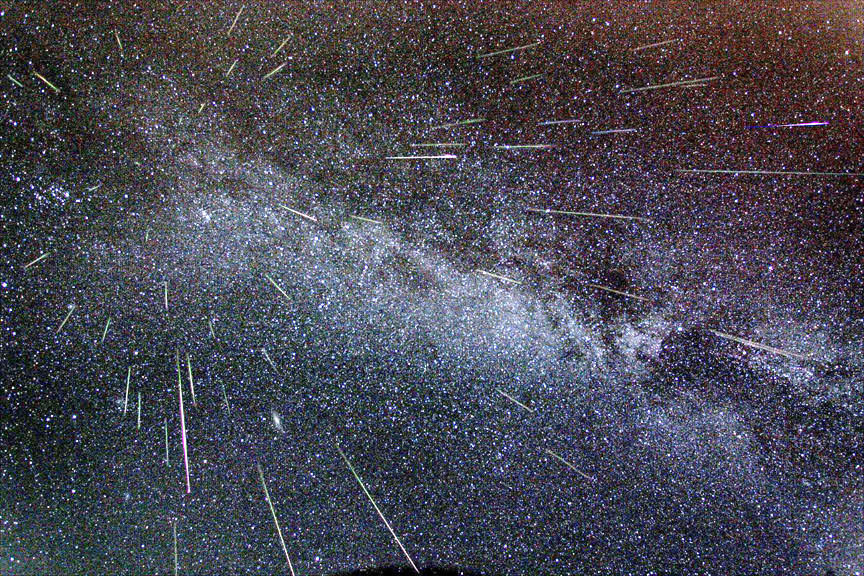
How can there still be debris from a comet that passed in 1862. Wouldn’t the debris be travelling at speed all that time ?
Spacer,
The comet lays down various filaments of debris during passes. The particles spread and thin over time (depending on dense a trail it is) but remains within or near the comet’s orbit. The Earth sometimes passes through these old filaments as it encounters the comet’s broad debris trail, and meteor counts temporarily rise and fall. Does that help?
Yes it does. Thanks.
So if I understand, a given meteor, whose flash we see now, “detached” from the comet long before the comet passed the part of the sky we’ll be travelling through….or has done one or more orbits of the sun and we pass through the comet’s orbit.
I also really enjoy your posts Bob. Thank you.
Spacer,
Thanks! Yes, you got it. The particles detached on a previous go-round and we’re only seeing those now when we slice through the stream of debris. There are probably tons of dust thinly scattered along the comet’s orbit. Every time Swift-Tuttle makes another close passage of the sun, it adds another deposit of fresh dust.
The debris is following the same orbit as the comet it came from. Meteor showers are ancient trails from comet tails. Well, historically ancient, not geologically ancient. They don’t last very long, but 1000 years is just the beginning of sweeping it up or spreading it out.
(I always appreciate Bob King’s posts there, even if I’m an armchair astronomer who never looks up, I always learn something new from these blog posts).
Far Away,
Thank you again for your kind words.
I love the Perseids as usually they are quite reliable and the counts generally higher than most showers, the Leonids also. Back in 1994 I belonged to a group of amateur astronomers we called ‘The Wragg Canyon Star Gazers’. (Last week that area experienced a large forest fire, just missing our host’s old house/ranch – she’s since moved to Oklahoma) That observing site was just south of the southern end of Lake Berryessa… a very dark and dry location. That year we gathered to watch what was billed as a possible meteor storm and we were not disappointed. We counted 284 meteors per hour with a couple dozen very bright fireballs/bolides which were VERY impressive. I hope that happens again. Near dawn as we were putting our gear away, one of the bolides lit up the whole sky! I thought someone behind me had taken a picture using a flash or strobe. Then came a sonic boom! Nice! We could easily see our shadows and then saw a lingering meteor train which lasted for several minutes!
The very best meteor shower/storm I’ve witnessed were the Leonids in 2001 where we counted ~1,000/hour! A once in a lifetime occurrence? Hmm…. Yah just never know.
I’m keeping an eye on the extended forecast for my area and see that we will probably be under a marine layer here by the coast. BUMMER! Looks like I may have to drive somewhere to get a view? Time will tell. Get your act together you weather gods! LOL
Aqua,
Reading your tale makes us that much more excited for the Perseids even if the counts won’t approach the Leonid storm. While more meteors are better, I’ve found the slower rhythms of more typical showers nearly as enjoyable.
Key to my above comments is the statement, “Yah just never know…” I hope this encourages everybody to get out there and take a look at this shower, because even though we are getting better at predicting the strength of any given meteor shower… you can always expect the unexpected!
Hi Bob… I have a big problem with celestrial events like meteors, auroras…SNs… eclipses: I live in Ireland and… guess why this island is called GREEN? Right – mostly cloudly!
The only “famous” irish astronomer is Joycelyn Bell and she used Radio waves to detect the LGMs in the Crab nebula.
So guess what the forecast is for the 13th??? 😉
TedH,
I understand your plight. You should try listening to the Perseids on FM radio then. Here’s information on how to do it: http://www.skyscan.ca/meteor_radio_detection.htm
Thanks for the link, Bob. That means sitting in the car for some hours (we don’t have any old-fashioned Tuner any more. Online-Radio is the magic word). But maybe we’re lucky? I’m the LastOptimistStanding!
TedH,
Sorry to hear you don’t have anything portable. Doesn’t have to be anything fancy – a clock radio would do.
I like to use the i-net to listen in when cloudy or during a bright moon. Here’s a site from Roswell NM, where meteoric ionization trails are radar bounced and converted into an audio broadcast. The sounds meteors make are VERY strange at times and utterly alien! http://www.roswellastronomyclub.com/radio_meteors.htm
Sounds from meteors? Yes! They can actually generate sound, aside from rare sonic booms. During the Leonid storm I mentioned above, one of the group I was with laid down on a blue plastic tarp. He said he kept hearing strange noises.. I laid down next and also heard them when a bright meteor passed by. A kind of tribo electric or static electric propagated transmission that the cold plastic attenuated. It was very cold and dry that night…
Lord Ross built the biggest telescope in the world at Birr, Co. Offaly. Surely he counts as a famous astronomer.
yes Spacer, I’ve seen it (2x).. it’s impressive but… no longer active. It’s been taken apart and the mirror is now inside (the museum) and in a very “un-reflective” condition. The tube is outside… unprotected and since we’re in Ireland: washed by the rain! But beside the weather: I like this island and the history / geology.
We have had an interesting couple of months and still more to come thanks Bob and we all look forward to your photo shots from this great Perseid Meteor Seasonal Event…
Help Us
We who live in the Southern Hemisphere seem to be the forgotten race.
Please help us too with directions for viewing these rather amazing events.
Thanks